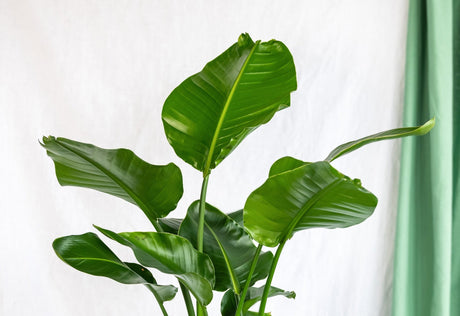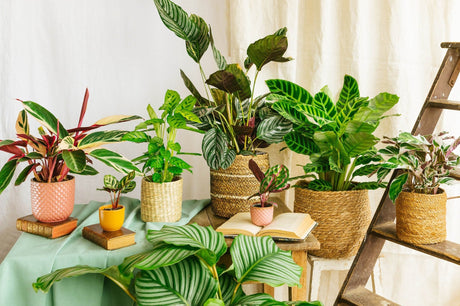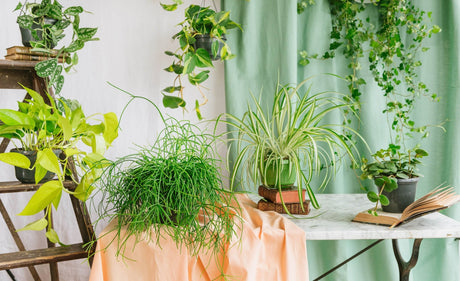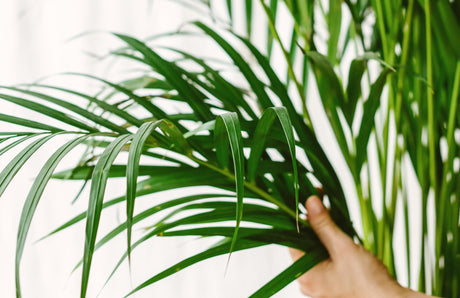Native to tropical regions Central and South America, Anthurium is relatively easy to maintain, but it requires some care specific to thrive and produce a vibrant bloom.
Among the most captivating botanical gems, the Anthuriums come in a multitude of varieties dazzling, among which the sumptuous Lemon Anthurium and the bewitching Peach Anthurium stand out with elegance.
Lemon Anthurium, with its bright and vibrant hue, brings a touch of energy to any space. Its vibrant petals and delicate contours create a visual dance, a true celebration of nature in its most dynamic form.
Peach Anthurium, meanwhile, embodies softness and elegance. Its pastel and delicate tones evoke a delicate watercolour.
1. Watering an Anthurium
Prefer watering moderate and regular rather than excess water in once only once. Water the plant until water begins to flow through the drainage holes in the pot, then empty the tray under the pot to prevent excessive moisture buildup.Tip: Iinsert your finger in the ground to about 2-3 centimeters of depth. If the soil is dry at this level, it is time to water. Avoid overwatering, as the roots of Anthurium are susceptible to rot.
2. Watering techniques
Watering from below
Place the jar in a saucer or shallow tray filled with non-chlorinated water. Let the root system absorb water by capillarity. When the top of the soil is wet, empty the excess water into the saucer to avoid stagnation.Watering at regular intervals
Establish a regular watering schedule based on the ambient humidity and temperature of your environment. For example, in general, watering every 1-2 weeks might be fine. Adjust the frequency based on seasonal needs and your home conditions.3. The exposure of an Anthurium
The Anthurium thrives in light indirect bright. Avoid the direct rays of the sun which could burn the leaves delicate of the plant. A filtered light through thin curtains or a position a few meters from an oriented window is generally ideal.Protect your Anthurium from temperature variations and draughts. Avoid placing it near intense heat sources, such as radiators or air conditioners.
4. When should I repot my Anthurium?
It is recommended to repot your Anthurium every two to three years. The best time to do this is in spring, when the plant enters its active growth period.
Here are the slines of potting:
Root crowding
If you observe that your Anthurium's roots are starting to take up all the space in the pot and push against the sides of the container, that's a clear sign that it needs a bigger pot to keep growing.Substrate depletion
When the soil in the pot becomes compacted, depleted, and no longer holds moisture as well as it used to, it may indicate that the plant has depleted nutrients and it's time to repot it in a fresh mix.Slowed growth
If your Anthurium stops growing, new leaves are smaller than usual, or flowering wanes, it could be a sign that the plant lacks space to grow properly.Insufficient drainage
If you notice that water collects quickly on the surface of the soil after watering, instead of seeping into the pot, this may indicate insufficient drainage due to overly dense roots.5. What fertilizer should I use for my Anthurium?
To feed your Anthurium properly and promote growth healthy and flowering abundant, it is important to use a fertilizer balanced specially formulated for houseplants.
Application frequency
In general, it is recommended that you fertilize your Anthurium every 4-6 weeks during its active growth period, usually in the spring and summer. Reduce frequency during fall and winter months when growth slows.Dilution
Carefully follow the instructions on the fertilizer package to get the right dilution. Generally, dilute the fertilizer in the watering water according to the instructions provided.Pre-watering
Before applying the fertilizer, water the plant lightly to avoid burning the roots with a high concentration of fertilizer.6. How do I multiply my Anthurium?
The method you can use to multiply your Anthurium is called division.Select a plant healthy with roots strong and prepare a new pot with a mixture of potting soil suitable. Gently remove the mother plant from the original pot to expose the roots. Divide carefully part of the plant with some leaves and roots. Place the new section in the new pot and cover lightly with soil. Water moderately to moisten the soil, without over-watering.
7. Diseases of an Anthurium
Anthuriums are generally resistant to diseases when properly cared for, but it is important to know the problems potential to be able to remediate quickly. Here are some diseases and problems common that can affect an Anthurium:
Root rot
An overabundance of moisture in the soil can lead to root rot. Signs include yellowing leaves and wilting, even after watering. To prevent this, make sure the pot has good drainage and adjust watering habits.Oidium
This fungal disease appears as a powdery white coating on the leaves and stems. It can be treated with appropriate fungicides and avoiding wet conditions.Grey rot
Gray mold is manifested by soft brown spots on the leaves. It can spread quickly and is caused by fungi. Avoid watering over the leaves and ensure good air circulation to prevent this disease.Bacterial rot
It causes watery, dark spots on the leaves, often surrounded by a yellow area. Avoid excess humidity and water stagnation to prevent bacterial rot.Cochineals
Mealybugs are small insects that suck sap from plants. They appear as cottony or brown growths on stems and leaves. Use biological methods or insecticides to eliminate them.Thrips
These insects feed on the leaves, leaving silvery or whitish spots. Use appropriate insecticides to control thrips.Nematodes
Nematodes are small, microscopic worms that attack roots. Symptoms include yellowing and wilting of leaves. Treatment can be difficult, so prevention is best by keeping plants healthy and avoiding overcrowding in the soil.8. Delivery and receipt of your plant
- Your plant is dry
- Is your plant wet ? Let the potting soil dry.
- Should I repot my plant right away ? No ! Wait until next spring or for signs that your plant needs repotting.






